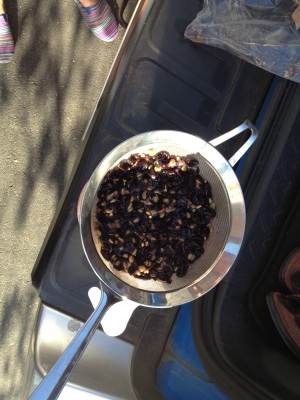Right now we’re doing a lot of testing and sampling. Sometimes we have Millie go out and bring samples back to us at home. When we’re at the winery we gather samples from that vineyard and test there. Most of the time though we go out and get samples and test them right in the field. The back of the FJ Cruiser is a completely odd assortment of gear right now. Both Stef and I have a change of shoes and socks in the car, there’s some dirty shirts, some mostly clean sweatshirts, tie downs, peanuts, apples, bottled water, a trailer hitch, plastic bags (for samples), clippers, and an assortment of test equipment and gear.
When we arrive on site we take out the plastic bags and start walking rows. Usually we walk every row picking berries from both sides. We then meet back up and combine the grapes. Stef smashes them and strains the juice. The first test actually happens as we pick. We’re tasting as we go. We’re also checking for the toughness of the skins. If they are tough, the tannins in the wine will be tough. Once strained we want to see most of the seeds brown and the juice should be reddish. Really unripe grapes will have brown juice. The picture below I would call brick red.
Next we have this handy field temperature and pH meter. The temperature is important because it will effect the other readings. The pH meter is usually + or – .10 degrees from our experience. If in doubt we’ll run a full test in the lab, but usually it gives us a good feel for the acidity.
We like to run a hydrometer and refractometer test. They hydrometer tends to be more accurate. The picture below is actually from the day after we were in the field. We always bring the samples home and let them soak overnight then retest. With not ripe grapes there’s not much of a difference, but grapes over 24 Brix can soak up 2-3 degrees pretty easy. THis reading is right at 20.

Somehow Stef got a picture of the inside of a refractometer. This is from the same sample and shows a slightly lower Brix of 19.1 That’s why we like to do both tests.

And this is what you do after you’ve driven 112 miles round trip in stop and go traffic to get samples you knew probably were not close to ready but had to anyway because the vineyard owner was ready to pick in two days of you didn’t test.




